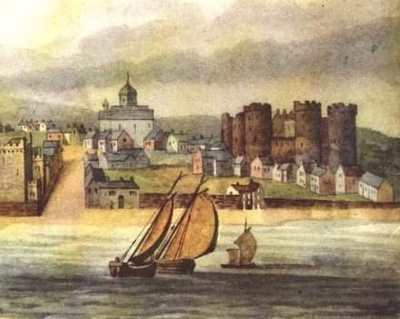A BRIEF HISTORY OF LIVERPOOL
Liverpool was 800 years old in 2007 and held the European Capital of Culture crown in 2008. Famous for music in the Beatles and others, and football clubs, however there is much more to Liverpool. A city rich in world history - Gateway to America and second city of the world's largest ever empire.
Roman Era-
Near to both Chester and Ribbchester, there is some evidence of Roman activity in the Liverpool area. Coins and Jewellery have been found across the region and the remains of a Roman era road were reportedly found running between Garston and Otterspool. Just beyond the city outskirts at what is now the M62 Tarbock Island, the remains of a Roman-era pottery factory were found.
The Middle Ages-
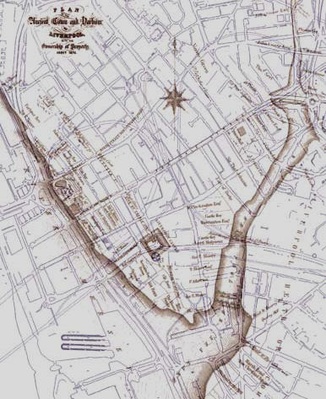 The Pool Superimposed on a Modern Map The great city of Liverpool began as a tidal pool off the River Mersey. It was probably called the lifer pol meaning muddy pool. There may have been a hamlet at Liverpool before the town was founded in the 13th century. Liverpool is not mentioned in the Domesday Book of 1086, being too small to merit a mention. West Derby, now a suburb of Liverpool is in the book. There were Viking settlements around the present day Liverpool, with the Wirral peninsular opposite Liverpool being a Viking stronghold – even today 50% of the men on the Wirral have Viking DNA.
The Pool Superimposed on a Modern Map The great city of Liverpool began as a tidal pool off the River Mersey. It was probably called the lifer pol meaning muddy pool. There may have been a hamlet at Liverpool before the town was founded in the 13th century. Liverpool is not mentioned in the Domesday Book of 1086, being too small to merit a mention. West Derby, now a suburb of Liverpool is in the book. There were Viking settlements around the present day Liverpool, with the Wirral peninsular opposite Liverpool being a Viking stronghold – even today 50% of the men on the Wirral have Viking DNA.
King John founded the port of Liverpool in 1207. The English had recently conquered Ireland and John needed another port to send men and supplies across the Irish Sea.
King John divided the land at Liverpool into plots called burgages on which people could build houses. He invited people to come and live in Liverpool. In the 14th century Liverpool probably had a population of about 1,000.
In the Middle Ages wine from France was imported through Liverpool, the main trading partner being Ireland. Skins and hides were imported from Ireland. Iron, salt and wool were exported.
Liverpool Castle was probably erected between 1232 and 1235 under the orders of William de Ferrers, 4th Earl of Derby. No record of the castle construction survive. Nearby in West Derby, there had long been a castle, which was taken by the Ferrers in 1232. By 1296 it lay in ruins.
Liverpool castle was built to protect King John's new port of Liverpool and was sited at the top of modern day Lord Street, the highest point in the town and overlooking the tidal Pool. The location of the castle is the Queen Victoria Monument in Derby Square.
Later, during the English Civil war the castle saw a bloody battle. In 1644 Royalist Prince Rupert and his men took the castle, which was later taken back by Parliamentarian Sir John Moore. Much later, Protestant supporters of William of Orange seized the castle in 1689. The castle fell into disrepair being an eysore. The last remaining ruins of the castle were removed in 1724.
In the village of Rivington, at Rivington Pike, on the West Pennine Moors near Chorley there is a scaled down rebuild of a ruined Liverpool Castle.
The 16th and 17th Centuries-
In the 16th century Ireland was still Liverpool's main trading partner. Salt was exported to Newfoundland. The port also benefited when English troops were transported to Ireland to put down rebellions in the 16th and early 17th centuries.
Liverpool was growing, however still had a population of only 2,000 in 1600. The population of Liverpool probably reached 2,500 by the time of the English civil war in 1642.
In the English civil war, initially Liverpool was in Royalist hands, however in May 1643 Parliamentarian soldiers took the town. Ditches were dug with earth ramparts erected around Liverpool in defence of royalist attack. In June 1644 Prince Rupert led a Royalist army to attempt and re-capture Liverpool. He described the town as a 'mere crows nest which a parcel of boys could take'.
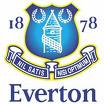 The first attacks were repulsed. The Parliamentary troops left by sea for more pressing needs elsewhere, leaving the people of Liverpool to defend their town themselves. The Royalists attacks on Liverpool were resisted fiercely by the townspeople, however were overcome with many killed. The Royalist troops then sacked the town. Prince Rupert's tower at Everton, around where he stayed before the attack, is incorporated in the badge of Everton Football Club, one of the oldest football club's in the world. Parliamentarian forces under Sir John Moore eventually retook the town.
The first attacks were repulsed. The Parliamentary troops left by sea for more pressing needs elsewhere, leaving the people of Liverpool to defend their town themselves. The Royalists attacks on Liverpool were resisted fiercely by the townspeople, however were overcome with many killed. The Royalist troops then sacked the town. Prince Rupert's tower at Everton, around where he stayed before the attack, is incorporated in the badge of Everton Football Club, one of the oldest football club's in the world. Parliamentarian forces under Sir John Moore eventually retook the town.
Being a natural deep water haven Liverpool began to grow rapidly in the late 17th century with the growth of English colonies in North America and the West Indies. Liverpool was, obviously, well placed to trade with colonies across the Atlantic.
At the end of the 17th century a writer named Celia Fiennes visited Liverpool giving a glowing report, writing:
Liverpool is built on the River Mersey. It is mostly newly built, of brick and stone after the London fashion. The original town was a few fishermen's houses. It has now grown into a large, fine town. It is but one parish with one church though there be 24 streets in it, there is indeed a little chapel and there are a great many dissenters in the town - Protestants who did not belong to the Church of England. It's a very rich trading town, the houses are of brick and stone, built high and even so that a street looks very handsome. The streets are well paved. There is an abundance of persons who are well dressed and fashionable. The streets are fair and long. It’s London in miniature as much as I ever saw anything.
The 18th Century-
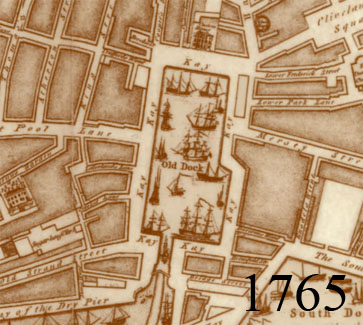 City Growth Around the Old Dock In the early 18th century the writer Daniel Defoe commented on Liverpool's booming trade, writing:
City Growth Around the Old Dock In the early 18th century the writer Daniel Defoe commented on Liverpool's booming trade, writing:
Liverpool has an opulent, flourishing and increasing trade to Virginia and English colonies in America. They trade round the whole island (of Great Britain), send ships to Norway, to Hamburg and to the Baltic as also to Holland and Flanders.
Liverpool continued to grow rapidly. By the early 18th century the town had probably reached a population of 5,000. By 1750 the population of Liverpool had reached 20,000 and by 1801 77,000.
In 1795 there was an influx of Irish and Welsh as well as some Scandinavian and Dutch. The majority of the population were not native to the locale.
The world's first enclosed commercial dock was built in 1715 transforming the port setting the transformation to the large city of today. The 10 metre tides, the 4th highest in the world, meant ships were in a safe, water filled harbour and not at anchor in mid-river or on sand banks at low tide. Loading and unloading was made easy for fast ship turn-arounds. Four more docks were constructed. The prime trading commodity was Cheshire salt. At this time, Liverpool grew to be the third largest port in the country behind London and Bristol. The port of Liverpool ensured growth in small inland industrial towns like Manchester, which eventually grew into a large city.
The American War of Independence began in 1775, disrupting Liverpool's trade. American privateers attacked British merchant shipping trading with the West Indies, capturing the ships and cargoes. In 1778 France, Spain and Holland declared war on Britain. Liverpool ships in return attacked French, Spanish and Dutch ships and seized the cargoes - of which they were quite good at.
The Slave Trade-
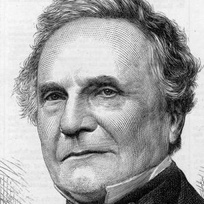 Slaves being bought at an African Port From about 1730 the merchants of Liverpool made profits from the slave trade. The trade formed the 'Slave Triangle'. Finished goods were traded to the Africans in return for slaves. The slaves were transported across the Atlantic to the West Indies and the Southern States with sugar, cotton and tobacco brought back to Liverpool.
Slaves being bought at an African Port From about 1730 the merchants of Liverpool made profits from the slave trade. The trade formed the 'Slave Triangle'. Finished goods were traded to the Africans in return for slaves. The slaves were transported across the Atlantic to the West Indies and the Southern States with sugar, cotton and tobacco brought back to Liverpool.
Liverpool was late in the slave trade behind Lancaster and Bristol, yet quite quickly eclipsed all others monopolising the trade. Two thirds of all slaves transported from Africa to the Americas sailed in Liverpool ships. Slaves never entered the port of Liverpool. The reality was that the slave trade was only a sideline for many merchants and shippers, being just one of the legs in the trade triangle, not the foundation of the great port. When slavery was abolished in 1807 it made little impact to the ports economy, with many prominent Liverpool people campaigning against slavery.
After the abolition of slavery, many slave merchants turned to building cheaply made, congested housing around the dock areas to cater for the expanding port - which quickly turned into slums. They turned from dealing from one human misery to another.
The 19th Century - The World City Emerges
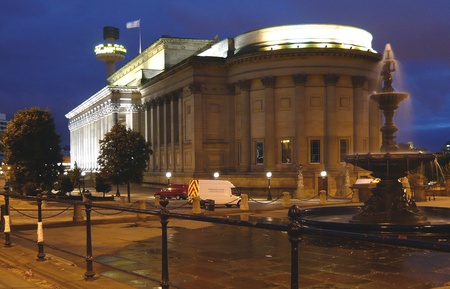 St. George's Hall - the world's first air conditioned building In this century Liverpool rose to one of the world’s richest cities and the largest and most advanced port in the world. The first world-city. The first city to have trading connections with all parts of the globe.
St. George's Hall - the world's first air conditioned building In this century Liverpool rose to one of the world’s richest cities and the largest and most advanced port in the world. The first world-city. The first city to have trading connections with all parts of the globe.
In 1801 the population of Liverpool was about 77,000. By 1821 the population had reached 118,000 and by 1851 376,000. Many Irish immigrants poured into the town in the early 19th century, reaching a peak during the Irish potato famine in the 1840s. Many died of disease as they inundated the town creating mass overcrowding – a mass grave of 6,000 is at Anfield Cemetery between Liverpool FC and Everton FC football stadia. Church graveyards contained mass graves too. A total of 1.3 million Irish entered Liverpool. Most immediately left for America or other parts of the UK.
What propelled Liverpool forwards as a rich major world city was:
-
The naturally deep water River Mersey - which accommodated the increasingly large steam ships of the 1800s.
-
The steam engine - which would operate the locks and "impound" the docks to greater depths at neap tides to accommodate very large ships. Steam ships were increasingly built larger giving more reliable schedules not relying on winds. Steam operated heavy lifting equipment with steam trains transporting cargo swiftly to and from other inland towns and cities. City shipping lines such as Alfred Holt, improved the steam engine, giving greater range enabling steam ships to sail to India and beyond expanding the city's markets.
The deep river and steam engines propelled the city and port forwards giving very fast ship turn-arounds when in port. Ports accessed by shallow rivers, like Lancaster and Bristol fell behind being quickly dwarfed by Liverpool. The interconnected enclosed dock system was extended to be the largest in the world. The interconnected docks system gave ships movement from dock to dock to load and unload at any time, without entering the tidal river. The system on the Liverpool side of the river was 12 kilometers long and about 4 kilometers long on the Wirral peninsular, with three docks at Garston further up the river.
American writer Herman Melville wrote of Liverpool:
"Previous to this, having only seen the miserable wooden wharves and shambling piers of New York... in Liverpool I beheld long China walls of masonry; vast piers of stone; and a succession of granite-rimmed docks, completely enclosed. The extent and solidity of these structures seemed equal to what I had read of the old pyramids of Egypt. In magnitude, cost and durability the docks of Liverpool surpass all others in the world... for miles you may walk along that riverside, passing dock after dock, like a chain of immense fortresses."
Melville's comparison with the pyramids is quite astute, as the scale of the constructions of Liverpool and Birkenhead docks is impressively immense. Mersey Docks & Harbour Board owned their own granite quarry in Scotland to cater for vast scale of the constructions. Virtually all of the 7.5 miles of Liverpool Docks were built into the river.
The port boomed and many new docks were rapidly built. All aspects of the cargoes leaving and entering the port were managed by the city: banking, insurance, shipping agencies, shipbuildings, transportation and manufacturing relating to all aspects of shipping. A number of companies engaged in clock and ship’s chronometer manufacture. In the 1500s Liverpool and the adjacent small town of Prescot which is now virtually a suburb, were world leaders in timepiece manufacturing. Chronometers and ships optical instruments were made at Liverpool.
By the middle of the century Liverpool's port was second in size only to London and often overtook London. Liverpool dealt with mainly import and export using larger deep sea vessels too large to enter London. The Manchester ship Canal from the River Mersey estuary to Manchester, was completed in 1894, taking ocean going ships 50 kilometres inland.
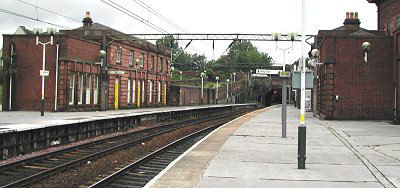 Edge Hill Station - World's Oldest Used Railway Station The world's first passenger railway was at Liverpool. A train left for Manchester in 1829. Long extensive tunnels were built under the city to take goods to the north end and south end docks to move cargoes as a fast as possible to improve ships turn-arounds. The 1829 Wapping Tunnel from Edge Hill to the South End docks, was the first railway tunnel in the world to be driven under a metropolis.
Edge Hill Station - World's Oldest Used Railway Station The world's first passenger railway was at Liverpool. A train left for Manchester in 1829. Long extensive tunnels were built under the city to take goods to the north end and south end docks to move cargoes as a fast as possible to improve ships turn-arounds. The 1829 Wapping Tunnel from Edge Hill to the South End docks, was the first railway tunnel in the world to be driven under a metropolis.
The largely original, 1836 Edge Hill Station is the world's oldest used rail station. The world's oldest used rail tunnel is at Edge Hill station.
Liverpool 'officially' became a city in 1880, although was actually a city in size for about 50 years previous. By 1881 the population had reached 611,000.
 Liverpool was the unofficial home port of the American Confederate Navy in the American Civil War. On outbreak of war, the Confederacy had no fleet, they built one while based in Liverpool. The city supplied warships and crews, guns, munitions and provisions for the army. The last official lowering of the American Confederate flag, the stainless banner, was at Liverpool, when CCS Shenandoah surrendered to the Lord Mayor of Liverpool, rather than to Northern Union forces, sailing from Alaska to Liverpool to surrender.
Liverpool was the unofficial home port of the American Confederate Navy in the American Civil War. On outbreak of war, the Confederacy had no fleet, they built one while based in Liverpool. The city supplied warships and crews, guns, munitions and provisions for the army. The last official lowering of the American Confederate flag, the stainless banner, was at Liverpool, when CCS Shenandoah surrendered to the Lord Mayor of Liverpool, rather than to Northern Union forces, sailing from Alaska to Liverpool to surrender.
Liverpool's involvement was so deep, after the conflict the USA was prompted to demand vast reparations for the damages caused by the mainly Liverpool built Confederate ships, especially the Lairds built CSS Alabama. After arbitration in Geneva, the U.S.A. was awarded $15,500,000.
During the 1800s Liverpool excelled in innovation. Oriel Chambers, the world's first steel framed glass curtain walled building was built in 1864, being the mother of the modern building. St. George's Hall was the world's first air conditioned building. Lime Street station had the largest iron roof on any building in the world - the first single span construction used to cover a railway station. Railways entered the city and long tunnels bored under the streets. Iron ships were pioneered in Liverpool. The first outside radio signals were transmitted at the city University of Liverpool.
In the early 1800s Liverpool began populating America in large numbers. Millions of people from all over Europe made their way to Liverpool booking a passage to America. More people left for America via Liverpool than any other port. A fact recognised by UNESCO in awarding World Heritage Status to the city.
In 1886 a rail tunnel was cut under the river, the world's longest at that time, creating an underground rail system with underground stations on both side of the river.
The Lumiere Brothers Liverpool Film 1897
The cinematography pioneers the French Lumiere Brothers, setup a business travelling European cities taking footage of the cities with their hand-wound cameras, and replaying to paying audiences. The Lumiere Brothers visited Liverpool only a few years after the invention of cinematography. The Lumiere brothers footage of Lime Street contains the first moving pictures of the city. Scenes were filmed across the city with the most famous the footage of Liverpool Docks from the Overhead Railway. This gave a wonderful innovative tracking shot at a time when camera lenses were still fixed in position, as the static opening scene in Lime Street indicates. The film starts at Lime Street, then onto filming the docks from the Overhead Railway. First is from Nelson Dock travelling south to Albert Dock, showing the now filled in Georges Dock, which has the Three Graces now upon the docks. The film cuts to Canada Dock with the timber quays and the Canada Dock accumulator tower clearly seen in the background. The film ends with footage from the top of a horse-drawn tram up Water Street and past the town hall.
The 20th Century
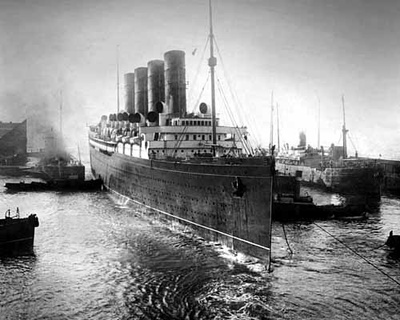 SS Mauritania entering Liverpool Docks By 1901 the population of Liverpool had reached 685,000.
SS Mauritania entering Liverpool Docks By 1901 the population of Liverpool had reached 685,000.
By the early 1900s Liverpool controlled much of the world's shipping and most of the world's largest ships were Liverpool owned: SS Mauritania and SS Titanic being amongst them. 40% of the worlds trade passed through Liverpool, the port was so large.
Liverpool played a key naval role in World War 1, with its extensive dock facilities. Millions of troops passed through the port.
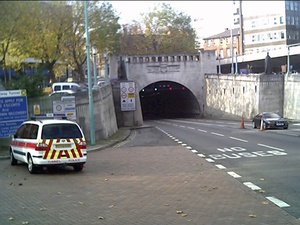 The First Mersey Road Tunnel In 1934 the Queensway road tunnel under the river was opened, which was originally designed to run trams under the road deck. The Kingsway Road Tunnel followed in 1971, giving three tunnels under the wide river. In the 1930s the current John Lennon airport was founded.
The First Mersey Road Tunnel In 1934 the Queensway road tunnel under the river was opened, which was originally designed to run trams under the road deck. The Kingsway Road Tunnel followed in 1971, giving three tunnels under the wide river. In the 1930s the current John Lennon airport was founded.
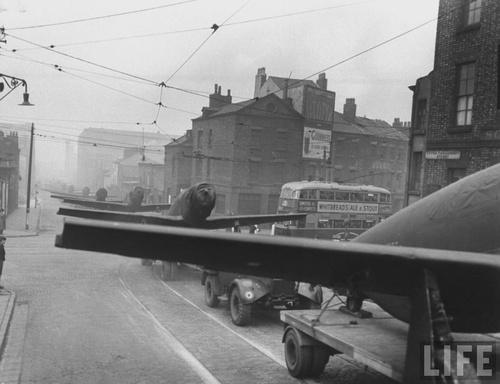 US P51 Mustangs being towed up Parliament St for full assembly at Speke During World War II Germany regarded Liverpool as a prime strategic target as it was the main convoy port with a convoy entering or leaving each day. Some 3,875 people died in Merseyside through German air raids, and more than 10,000 houses destroyed. Many more people were seriously injured and many more houses damaged. Canada Dock in Liverpool was the most heavily bombed square mile in the UK. Large sections of the city centre was destroyed. Bootle had more buildings in percentage terms damaged than any other town or city.
US P51 Mustangs being towed up Parliament St for full assembly at Speke During World War II Germany regarded Liverpool as a prime strategic target as it was the main convoy port with a convoy entering or leaving each day. Some 3,875 people died in Merseyside through German air raids, and more than 10,000 houses destroyed. Many more people were seriously injured and many more houses damaged. Canada Dock in Liverpool was the most heavily bombed square mile in the UK. Large sections of the city centre was destroyed. Bootle had more buildings in percentage terms damaged than any other town or city.
Ironically, the last house to be bombed in Liverpool by the Luftwaffe was Hitler's brother's old house in Upper Stanhope Street.
Millions of troops and war materials passed through the important port.
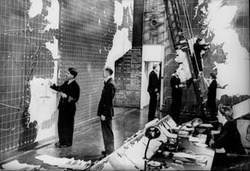 Derby House
Derby House 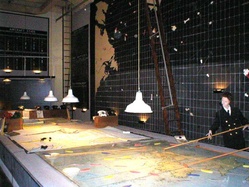 Battle of the Atlantic Control Room
Battle of the Atlantic Control Room
the only thing that ever really frightened me during the war was the U-boat peril - Winston Churchill
The Battle of the Atlantic, the U-Boat war, was centred at Derby House in Liverpool. The war rooms are still intact and open to visitors.
In the later 20th century industries in Liverpool included engineering, car manufacturing, cement manufacture, sugar refining and flour milling, banking and insurance. However, the large port was still paramount. For a time, in the 1950s and 1960s the local economy boomed, turning sour in the late 1970s and 1980s as Liverpool, like the rest of the country, suffered from recession. Flags of convenience for ships played against the port. The decline of British manufacturing industry played a big part. Less cargo was passed through the port - less imported raw materials to manufacture goods and less finished goods exported. The quantity of finished goods imported rose being transported mainly in containers. Liverpool had turned to large scale manufacturing as the city expanded, this industry sector was seriously affected by the British turndown.
Container ships became very large with container handling far less labour intensive. Fewer ships were being used to transport equivalent tonnages of goods. To cater for the new container trade Liverpool built the Seaforth Dock container terminal in 1971, the largest dock in the UK incorporating the world's largest dock gates. Simultaneously, most of the now small and outdated south end docks closed. Seaforth Dock became a free port in 1984. Despite large moves to keep ahead, Liverpool became an unemployment black spot from being the second richest city in the world only 90 years previously.
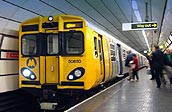 As London did in the 1930's, in the mid-1970s the unconnected dispersed rail lines around Merseyside were merged into a rapid transit metropolitan railway system, named Merseyrail. New underground stations and tunnels were built under the city and in Birkenhead creating the largest metro system outside of London. Liverpool has an extensive, superb legacy of disused Victorian rail lines, trackbeds, tunnels and stations, awaiting re-use and merged into Merseyrail. A extended Merseyrail would serve more of its targetted population than any other metro system in the UK.
As London did in the 1930's, in the mid-1970s the unconnected dispersed rail lines around Merseyside were merged into a rapid transit metropolitan railway system, named Merseyrail. New underground stations and tunnels were built under the city and in Birkenhead creating the largest metro system outside of London. Liverpool has an extensive, superb legacy of disused Victorian rail lines, trackbeds, tunnels and stations, awaiting re-use and merged into Merseyrail. A extended Merseyrail would serve more of its targetted population than any other metro system in the UK.
Being a large port that reached to all parts of the globe, Liverpool acquired a cosmopolitan population – Europe’s oldest Chinese community emerged in Liverpool. The black population is small and confined largely to one area of the city. The black community is old going back many generations. Dutch, German and Scandinavians all settled in the city in numbers. This mix of cultures has led to a creative music scene, with artists like the Beatles becoming world famous. The mix of people created a unique accent unlike the accent of adjacent Lancashire. In the English speaking world, the only accent specific to a city is the Liverpool accent - all others are specific to regions.
A dish associated with the city is a stew, Scouse. This dish is indicative of the cosmopolitan origins of the city deriving from Scandinavia, labskaus.
The Present & Future
 Albert Dock
Albert Dock 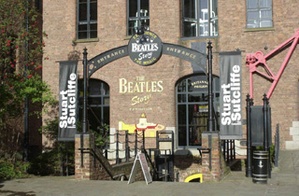 Beatles Museum
Beatles Museum 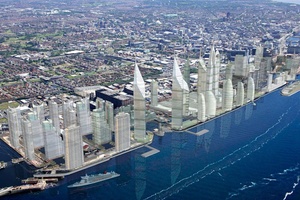 Planned Liverpool Waters
Planned Liverpool Waters 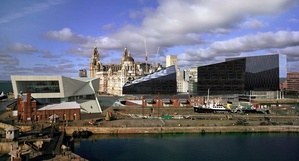 Mann Island In the last years of the 20th cekntury hopeful signs emerged. Liverpool remains a very important port, despite the decline from the 1970's onwards. Because of its position on the English north west coast it is the main port for trading with North America. Liverpool is the only deep-water port on the coast. The container terminal is to be extended to accommodate Post-Panamax ships, the largest afloat. The expanding port is dealing with more cargo than ever before and deals with the largest variety of cargos.
Mann Island In the last years of the 20th cekntury hopeful signs emerged. Liverpool remains a very important port, despite the decline from the 1970's onwards. Because of its position on the English north west coast it is the main port for trading with North America. Liverpool is the only deep-water port on the coast. The container terminal is to be extended to accommodate Post-Panamax ships, the largest afloat. The expanding port is dealing with more cargo than ever before and deals with the largest variety of cargos.
John Lennon airport is Europe's most rapidly expanding with an air cargo terminal planned to mesh into the sea port. The airport was assessed as the easiest to expand being on the riverside with planes flying over the wide river estuary with minimal environmental impact. Pressure is being put to open a rail station at the airport giving local Merseyrail metro, and main line connections. North Wales is pushing to be on the Merseyrail metro system, with a direct rail connection to the airport by electrifying the Wrexham to Bidston line giving direct underground city centre access and onto John Lennon airport.
The city centre has been heavily developed, with skyscrapers being erected along the riverfront and dock areas. Many of the UK's tallest buildings are planned on the old abandoned docks areas and waterfront with ambitious plans for the old Central Docks. Expectations are to double the city's population and establish Liverpool as a world renowned financial and leisure centre with Liverpool Waters and Wirral Waters central to this plan. In the 1980's the historic and abandoned Albert Dock were redeveloped and turned into a unique area of bars, shops, apartments and restaurants.
The Bold Street area is to undergo a transformation in the form of Liverpool Central Village. This will be built in the area long vacated by the old Liverpool Central high level railway terminal building. As part of the development, adjacent department stores will be brought back into full use. A new European alfresco dining square and two new towers are to be built, containing bars, shops and restaurants and office space. A man-made, canal-like, water feature is central to the complex. The complex is to mesh into the adjacent Bohemian quarter of arts organisations and musicians. - link to complete overview
Both Football clubs, Everton FC and Liverpool FC, have plans for new stadia. However, many claim an opportunity is lost to develop a Centre of Soccer Excellence merging the two clubs into one complex, with one transport infrastructure for the whole complex.
Liverpool is now promoting tourism using history and heritage as a prime attraction. The United Nations declared much of the docks and the city centre a World Heritage Site. The city is regarded as being important to world history and heritage, being crucial in the largest migration of people in world history. The city has many cruise liners visit the city in the summer months, besides cruises that start and finish from the city. A new cruise liner terminal has been built to cope.
Music and football is important in attracting tourists. The city maintains a healthy music production industry still producing top quality musicians. The city can proudly boast more British number one hit records by its musicians than other city. The Royal Liverpool Philharmonic Orchestra plays to full houses at the art deco Philharmonic Hall.
The city is the most filmed outside of London, with many films, British and foreign, shot using the old dockside warehouses and old city centre streets. Film studios have been created in Garston in the south of the city.
Today the population inside the city boundary of Liverpool has stabilised being 439,000 dropping quickly from a high of near one million, although most of the population exodus was to small towns abutting the city still in the soci-economic sphere of Liverpool. The city population is slowly increasing as exiled Liverpudlians return and outsiders are attracted in. The Metropolitan County of Merseyside as a whole is approximately 1.5 million people.
Carl Jung aptly said Liverpool is the pool of life


